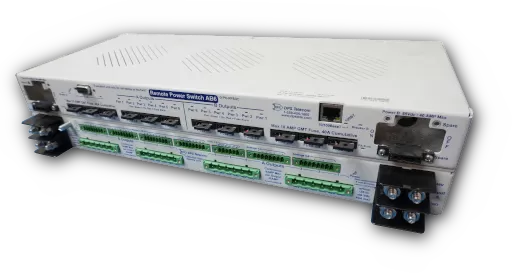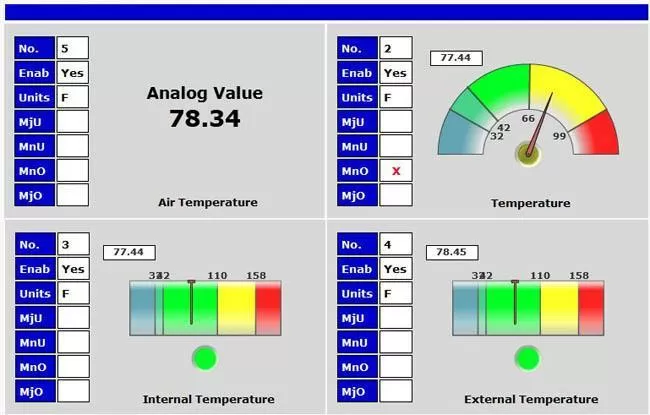Check out our White Paper Series!
A complete library of helpful advice and survival guides for every aspect of system monitoring and control.
1-800-693-0351
Have a specific question? Ask our team of expert engineers and get a specific answer!
Sign up for the next DPS Factory Training!

Whether you're new to our equipment or you've used it for years, DPS factory training is the best way to get more from your monitoring.
Reserve Your Seat TodayThe most basic Power Distribution Units (PDUs) are simply power strips that are used in data centers, server rooms, remote telecom sites, or simply any other environment that equipment needs to be toggled on or off.
However, thanks to modern technology, some PDUs have evolved into intelligent devices that allow network operators to remotely monitor power usage, energy efficiency, and even environmental conditions. These are called managed PDUs or switched PDUs.

Let's take a look at what managed PDUs can do for your company and uncover some ways that they can improve your efficiency.
Any managed PDU should be able to be accessed via a web interface. Through this interface, you are able to monitor and manage the devices connected to each port of the PDU and gather data about them.

An intuitive web interface makes it easy to issue commands, such as turn on, turn off or reboot, from your PC using just your web browser.
For most efficient managed PDUs, all you have to do is type in the IP address of your unit into your browser and press "return". Then you login to your PDU with your username and password (which prevents unauthorized access to your site's power control), and then issue your commands. You can also access the current status of all your power output ports from the web interface.
Imagine that your mission-critical device becomes unresponsive - when you need to force it to reboot, recovery time is critical. In this situation, if you have a basic PDU, you would need to dispatch a technician to the facility where the device is located to simply perform a hard reboot. Depending on where your site is located, this is a task that will require a whole day - while your network is down.
This is where a managed PDU pays for itself. In this same example, instead of sending your tech for a remote site that requires expensive truck rolls, all you need to do is log in to your PDU web interface and with a few clicks, you can power cycle your devices.
Remote switching on and off your remote devices will give you better control of your remote network.
If you need to know more than just the amperage being pulled from your PDU, then a unit with real-time remote monitoring capabilities is what you need.
Managed PDU units with remote monitoring features are an important type of Supervisory Control and Data Acquisition (SCADA) system device. This is because they can monitor and control remote processes and devices.
Monitoring capabilities allow you to monitor discrete and analog alarm data from your important gear at your remote sites. With current monitoring on each PDU output port, for example, you can know how much power each of your devices is consuming.
Also, make sure your PDU device is able to send you alerts (based on your user-defined parameters) when a problem in your network needs to be reported.
If you have only a few remote sites, then managing a small number of PDU devices is not hard - especially if they have an intuitive web interface. However, if you have a large network with multiple PDUs, then manually keeping tabs of all these different units by looking at multiple different screens affects your monitoring system's efficiency.
So, if you have a large network, the best practice is to deploy a master station in order to integrate all your PDU units and other monitoring equipment in only one centralized interface. Accessing your network's information in a central database makes it easy to monitor all your equipment at once, store the data, trend it and use it to make informed decisions.
It's important to make sure your master station can support many different communication protocols to allow for interoperability and smooth integration.

As I previously said, it's important that your master station is able to support many different communication protocols. Simple Network Management Protocol (SNMP) is one of them.
Although is it usually a technology present in remote terminal units (RTUs), it's important that your PDU is able to support SNMP as well. If you plan to deploy more than a handful of PDU units, then they have to be capable of integrating into your current alarm monitoring system. And most of these monitoring systems are based on SNMP. So, if your PDU is able to output SNMP, it will give you a big advantage when you're trying to integrate it with your master station (SNMP manager).
This integration offers multiple benefits. Being able to track the current state of each power output port and the power input of the PDU is one of them. Also, you can track for PDU hardware failures and other internal alarms.
But, most importantly, your managed PDU will be remotely controlled by your SNMP manager. This means that you can set up a fully automatic server and another equipment reboot/power cycling system.
If your SNMP manager gets a message from equipment that has become unresponsive or it doesn't get any message at all, then it will automatically send a power cycle request to your managed PDU. This all means that with SNMP integration there's no need for human intervention at all. But you'd still get an alarm describing the issue and action taken by your SNMP manager, this way you make any necessary adjustments.
Competent PDU units will also give you the ability to have complete environmental visibility.
With a device like that, you are able to monitor internal temperature, external temperature, and current draw for each input. This feature is valuable if you have unmanned remote sites because it allows you to detect and respond to network issues in a timely manner from your desk.
So, from your PC at your office, you can manage and operate controls, keep an eye on the temperature at your facilities, as well as keep track of your power consumption.
A PDU device is an important device that allows you to remotely cut power to your equipment, individually, from your office or even from your home. When you are using battery power, you can turn off gear that is not mission-critical in order to conserve your batteries - so your truly mission-critical devices will be able to run for a longer time.
For this main reason, PDUs are extremely helpful for power cycling your remote equipment, but they are mostly manual instead of automatic - you have to actually click buttons in an interface. Also, there are typically no analogs on a basic PDU to let you know about battery life remaining.
With managed PDUs, you can really extend the charge of your batteries during an outage, as these devices automatically shut down less important equipment when your batteries hit a critical low. Managed PDUs with this feature is certainly a step in the right direction, but don't forget they also need to include automated and intelligent decision making.
The best managed PDUs will have RTU functionality to allow you to monitor battery voltage. Your system will then be able to keep track of battery voltage natively. It'll be able to automatically power down equipment when critical battery thresholds are hit - based on your user-defined settings.
This will help you and your team by automating many processes that previously needed human involvement.
A managed device will let you calculate your operational costs for each device in your network. By knowing how much power each of your device uses, you can identify which equipment is using energy more than the acceptable.
With a PDU that has monitoring capabilities, it's easy for you to set thresholds, so you can know when gear gets close to circuit limits. Also, you can identify equipment that needs to be changed so your network can stay operational and protected.
Nowadays, there are many different types of PDUs out there from many different vendors. DPS managed power switches and APC managed PDUs are just two examples of competent PDUs in the market.
But, although there are many efficient options that you can choose from, not all of them will be the perfect fit for your unique network. To find the right model for your needs, you need to ask yourself these questions:
To avoid spending your budget on more than you need or on less than what you actually need, make sure your potential device meets all your requirements in one single unit. Off-the-shelf units are unlikely to meet all your needs to a T, so make sure your possible vendor can make changes to their units to support the features that you need.
When you deploy a managed PDU with real-time monitoring, you can better understand your usage vs. capacity and make informed decisions about your equipment and remote sites. But, for that, you first need to invest in a competent PDU unit.
Choosing the right PDU for your unique scenario is made easier with the help of our team of monitoring experts.
We are a trusted remote monitoring equipment manufacturer, and building perfect-fit solutions for whatever our clients need is our mission. We proudly offer field-proven devices that can be changed to accommodate any of your special requirements. But, we can also engineer-to-order brand new equipment to help you get the exact device that you need to help you reduce costs, increase power efficiencies, and enhance your network uptime.
If you have questions, don't worry - just contact our application engineers for more information.

Morgana Siggins
Morgana Siggins is a marketing writer, content creator, and documentation specialist at DPS Telecom. She has created over 200 blog articles and videos sharing her years of experience in the remote monitoring industry.